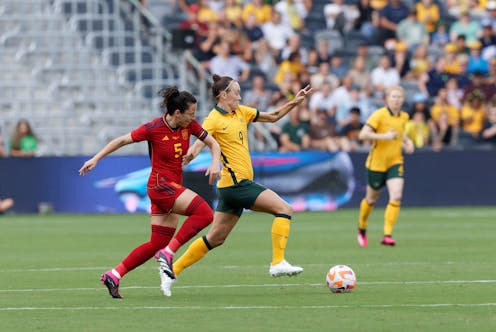Breast injuries are common for female athletes. Here's why better awareness and reporting are needed
- Written by Deirdre McGhee, Researcher and Senior Lecturer, University of Wollongong, APA Sports Physiotherapist, University of Wollongong

In the to and fro of daily life, an accidental knock to the breast can hurt for a moment. But in the push and shove on the sporting field – such as the upcoming 2023 FIFA Women’s World Cup – a blow to the breast can cause breast pain, swelling and bruising.
Coaches, health clinicians and sporting organisations don’t know enough about this silent, female-specific injury. And female athletes involved in sports like soccer or football need to be aware of the potential dangers. Our recent review paper outlines how risks vary as breasts change in structure and function over a lifetime – through puberty, pregnancy, lactation, menopause and following surgery.
Proper management of breast injury involves taking care of breast tissue during recovery and empowering athletes to make informed decisions about their participation in sports, work and leisure activities. First, we need to get a better sense of why and how often such injuries happen.
Read more: Long-range goals: can the FIFA World Cup help level the playing field for all women footballers?
Silent injuries
Breast injuries can happen to women in sporting and occupational settings – and from seatbelt trauma. They are usually silent injuries because although many female athletes experience them (some 50% of female college athletes in a United States study), as few as 10% report them to coaches or medical staff.
As a result, most injuries are not assessed or treated even though they cause symptoms that can last for weeks, negatively affect athletic and work performance and have long-term consequences, including:
- breast fat necrosis (or tissue death), that can result in fibrous lumps within the breast
- breast deformities and asymmetries from either the halting of breast development during puberty or the bursting of breast implants, with both requiring surgery if correction is sought
- damage to the milk ducts of lactating breasts that can affect breastfeeding.
Female athletes also suffer from frictional skin injuries from bras, and from breast pain associated with hormonal changes or excessive breast movement.
But injury does not cause breast cancer
One of the myths about breast injuries is an assumed link with breast cancer. Though an injury may draw attention to previously formed breast lumps or cause a new one, female athletes can be assured there is no evidence breast injuries cause breast cancer.
However, one of the long-term consequences of breast injuries, breast fat necrosis, can be challenging for doctors to distinguish from breast cancer. Female athletes must understand the importance of reporting breast injuries so they can be treated appropriately to minimise the risk of long-term effects.
To effectively monitor breast tissue recovery after a breast injury, female athletes also need to be familiar with the “normal” look and feel of their breasts because women’s breasts are not all the same. This practice of breast self- examination will also assist with the early detection and treatment of breast cancer, which affects one in eight women.
Protecting breasts
As women’s participation in sports that have been traditionally dominated by men increases, greater awareness about breast injuries is needed. Sporting organisations like FIFA have a duty of care to educate their female players, coaches and medical staff about breast injuries and improve their management and prevention.
Although female-specific, breast-protective garments are commercially available, there is currently no published evidence that they can decrease impact on the breast. Many female athletes and workers wear breast-protective equipment and body armour designed for the male torso. These may not fit women properly. Further research is required to investigate how effective body armour and breast-protective equipment is and to improve their design and fit for the wide range of female breast and torso shapes.
For women’s football and other sports, there needs to be better injury surveillance and records. Doctors, physiotherapists and sports trainers associated with female football teams need to trained to assess and treat breast injuries.
Sporting organisations like FIFA have made progress in supporting and promoting women to return to sports post-pregnancy and breastfeeding. But it is equally essential women are aware of the risks of damaging the delicate and enlarged glandular tissue within their breasts and their breastfeeding capability.
What’s next?
More research is needed to know how frequently breast injuries occur in sports like football, how severe they are or how frequently long-term changes occur. Because the cause and type of injury will be specific to the sport played, injury surveillance in each sport is needed.
But greater awareness and education about breast injuries should not deter women from participating in sport because they can be treated. Female players have worked hard and long to have the opportunity and skills to be involved in football at the World Cup level.
We hope our review and future research can act as a catalyst for sporting organisations like FIFA to raise awareness, educate and investigate breast injuries in women’s football so they can develop evidence-based guidelines, management and prevention strategies. The goal of these should be to maximise long-term breast health, athletic performance and women’s participation at all levels of sporting competition.
Authors: Deirdre McGhee, Researcher and Senior Lecturer, University of Wollongong, APA Sports Physiotherapist, University of Wollongong



